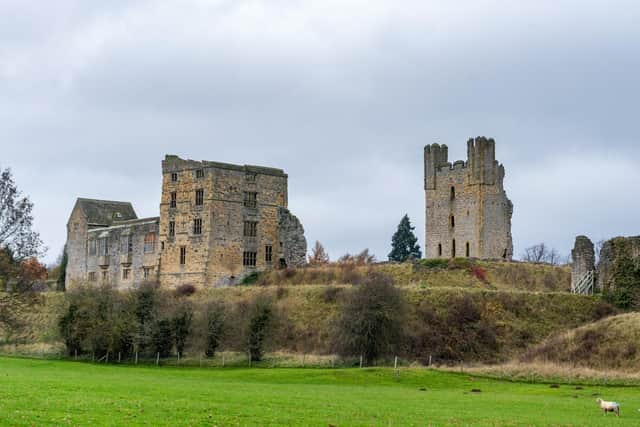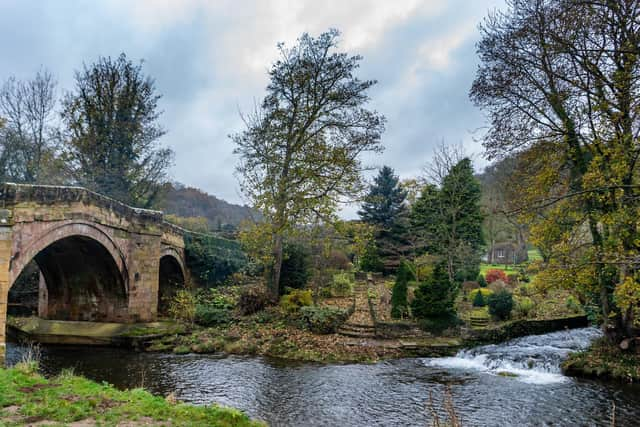Why picture-postcard town of Helmsley 'ticks all the boxes'
There is a buzz phrase beloved of marketing folk and those who want to sell or promote ideas, concepts or lifestyles to consumers. Does something, “tick all the boxes?”
Well, to use such modern parlance, Helmsley gets almost unanimous ticks of approval. It has charm, plenty of small independent shops, a lovely river, a nearby stately home and a market square graced by a strangely beautiful Victorian monument. It is the start of the 109-mile long Cleveland Way (which finishes on the coast in Filey), and it has as much history and heritage as you could throw a stick at.
Advertisement
Hide AdAdvertisement
Hide AdThe only box that remains unticked is a rail link. You have missed the last regular passenger service by more than 65 years, for it was withdrawn in 1953. When the line was opened in 1871, there was a celebratory dinner at the Black Swan Hotel. The hotel – parts of which date back to the 15th century – happily is still here and in normal times is popular with dog-walkers and those who want to explore the region, for just down the road in one direction is Castle Howard, and Rievaulx Abbey in another.


Right on the doorstep, however, is Helmsley itself, a place where Ryedale blends seamlessly and quietly into the Vale of Pickering. The western part of the town is actually in the North York Moors National Park. Helmsley is part of a huge conservation area of nearly 100 acres, and, if you want more statistics, there are 433 buildings within it, 48 of which are Grade II, which is impressive to say the least.
The Borough Charter granted to Helmsley, back in 1191, is rather special. It allowed the town to hold markets on specific days, it codified certain laws and the ways that they were imposed, it registered plots of land, and it was one of the very first in England.
The Charter had to be authorised at the very top – and the monarch on the throne at the time was Richard I, nicknamed ‘The Lionheart’. But it is barely credible that Richard even knew where Helmsley was on a map. Although he had been crowned King of England two years earlier, he was to spend only six months of his decade-long reign “at home”. The rest of the time he spent all over Europe and the lands adjoining the southern Mediterranean, fighting in one expensive crusade after another.
Advertisement
Hide AdAdvertisement
Hide AdCrusades put a heavy burden on the domestic exchequer, and handing out Borough Charters brought in a nice little levy from all sorts of communities across the kingdom. What the honest folk of Helmsley thought when they were asked to cough up even more revenue to pay for Richard’s ransom when he was unfortunately captured while returning from Palestine on his Third Crusade, is not recorded (though we can hazard a guess).


The Anglo-Saxon name for the town was Elmeslac, and that gives us a clue to the “backwoods” nature of the place – it means “Helm’s forest clearing”. By the time of that charter, Neolithic, Bronze and Iron Age folk had put their mark on this heavily-forested corner, and, after them, so had the Romans and the Vikings.
When the Normans imposed their rule, they carved up vast swathes of their new acquisition, handing over land to close members of their families, friends – and those whose favour they wished to win. And this part of Yorkshire was a prime site. It had timber, it was easily accessible and at the hub of many tracks and trails, a crossing point for the River Rye, and excellent territory for the favoured sport of the wealthy – hunting.
Just over to the west, was a royal deer park. The splendid Norman castle is clear evidence of the importance that was invested in the town, but throughout the entire Medieval period it was largely a peaceful existence. Edward III had bed and breakfast here for just under a week in 1334, and Richard III, who had purchased it over a century later, doesn’t even seem to have crossed the drawbridge – he preferred Middleham, instead.
Advertisement
Hide AdAdvertisement
Hide AdHelmsley and its castle hit the headlines during the Civil War, when it was besieged by Sir Thomas Fairfax. By then, it was owned by the Duke of Buckingham, a favourite at the court of Charles I. The garrison managed to hold out for three months before surrendering.
What made this gallant resistance all the more remarkable is that the castle was, by this time, far more of a mansion with walls rather than a fortress. Cromwell ordered the place to be “slighted”, which meant being rendered useless for any warring purpose. The house within, however, was largely spared.
With that, Helmsley’s time of frenetic excitement ceased. That is not to say that it became a dull backwater. Far from it. But it managed to keep its unique character. Straight through the middle of the town runs the frequently boisterous Borough Beck, which joins the Rye at the mellow stone bridge. There has been flash-flooding after heavy rainfall, and there are plenty of tales of the troubles it caused.
The aforementioned monument is to William Duncombe, the second Baron Feversham, who was something of a local character. He was once described as “a heavy, solid, good-natured man, whose speeches are of the most ponderous and soporific nature”, and “a man whose talk is of bullocks”. But his lordship knew what he was talking about – his livestock were celebrated in national agricultural shows, and were constant prize-winners.
Advertisement
Hide AdAdvertisement
Hide AdIn Parliament, he had a reputation for being a traditionalist and for being reliable and dependent to the Tory cause. Except in one major regard. Feversham gave weighty moral support to much-needed reform in Victorian factories. In one speech in York he rocked the establishment boat by declaring that: “This is not the cause of party, it is the cause of justice, the cause of real humanity, of Christian benevolence, the cause of the oppressed and the industrious poor.”
In the week of his death in 1867, The Yorkshire Post saluted him warmly, praising his “unfailing support” for the reform of industrial laws.
The Feversham family continue to be involved in public service, and to live at the impressive Duncombe Park (not open to the public), which has a beautiful walled garden which we can all explore at certain times of the year. There’s an on-going restoration programme and it was perfect as one of the locations for the recent film adaptation of The Secret Garden.
Helmsley is home to a thriving and popular local arts centre, while the green-fingered always ensure that the town is prominent when it comes to the top-ranking results in Britain in Bloom, and quite a few visitors are often surprised at the number of motorbikes that they encounter in the square – it’s a popular pull-up for bikers heading across the North York Moors.
Advertisement
Hide AdAdvertisement
Hide AdThe town has fought off invading Scots, survived the collapse of a significant weaving industry, and quietly developed itself into a centre for tourism and a haven for walkers.
And for a stroll by the Beck with an ice-cream on a balmy summer’s afternoon, it is pretty much unbeatable. Helmsley, you might just say, ticks all the boxes.
Support The Yorkshire Post and become a subscriber today. Your subscription will help us to continue to bring quality news to the people of Yorkshire. In return, you'll see fewer ads on site, get free access to our app and receive exclusive members-only offers. Click here to subscribe.